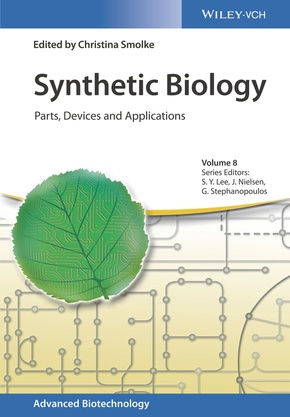
Synthetic Biology, 3 Teile - Parts, Devices and Applications
| Verlag | Wiley-VCH |
| Auflage | 2018 |
| Seiten | 409 |
| Format | 17,6 x 24,8 x 2,3 cm |
| Gewicht | 908 g |
| Artikeltyp | Englisches Buch |
| Reihe | Advanced Biotechnology 8 |
| ISBN-10 | 3527330755 |
| EAN | 9783527330751 |
| Bestell-Nr | 52733075A |
A review of the interdisciplinary field of synthetic biology, from genome design to spatialEngineering.Written by an international panel of experts, Synthetic Biology draws from various areas of research in biology and engineering and explores the current applications to provide an authoritative overview of this burgeoning field. The text reviews the synthesis of DNA and genome engineering and offers a discussion of the parts and devices that control protein expression and activity. The authors include information on the devices that support spatial engineering, RNA switches and explore the early applications of synthetic biology in protein synthesis, generation of pathway libraries, and immunotherapy.Filled with the most recent research, compelling discussions, and unique perspectives, Synthetic Biology offers an important resource for understanding how this new branch of science can improve on applications for industry or biological research.Advanced BiotechnologyBiotechnology i s a broad, interdisciplinary field of science, combining biological sciences and relevant engineering disciplines, that is becoming increasingly important as it benefits the environment and society as a whole. Recent years have seen substantial advances in all areas of biotechnology, resulting in the emergence of brand new fields. To reflect this progress, Sang-Yup Lee (KAIST, South Korea), Jens Nielsen (Chalmers University, Sweden), and Gregory Stephanopoulos (MIT, USA) have joined forces as the editors of a new Wiley-VCH book series. Advanced Biotechnology will cover all pertinent aspects of the field and each volume will be prepared by eminent scientists who are experts on the topic in question.
Inhaltsverzeichnis:
1 - DNA synthesis and genome engineering1.1 Competition and the Future of Reading and Writing DNA1.2 Trackable multiplex recombineering (TRMR) and next-generation genome design technologies1.3 Site-directed genome alteration with engineered recombinases/ZFs1.4 Rational efforts to streamline the E. coli genome1.5 Functional requirements in the program and the cell chassis for next generation synthetic biology 2 - Parts and devices supporting control of protein expression and activity2.1 Constitutive and regulated promoter engineering2.2 Splicing and Alternative Splicing Impact on Gene Design2.3 Application of RNA interference 2.4 RNA switches 2.5 Programming Gene Expression by Engineering Transcript Stability Control and Processing in Bacteria2.6 Standardized functional peptides and their application in superfunctionalizing proteins3 - Parts and devices supporting spatial engineering3.1 Metabolic channeling using DNA as a scaffold3.2 Synthetic RNA scaffolds for spatial engineering in cells3.3 Sequestered: Design and Construction of Synthetic Organelles4 - Early applications of synthetic biology: pathways, therapies, and cell-free synthesis4.1 Cell free protein synthesis: an emerging technology for understanding, harnessing, and expanding the capabilities of biological systems4.2 Applying Advanced DNA Assembly Methods to Generate Pathway Libraries4.3 Synthetic Biology in Immunotherapy05 - Societal ramifications of synthetic biologySynthetic Biology: From Genetic Engineering 2.0 to Responsible Research and Innovation
